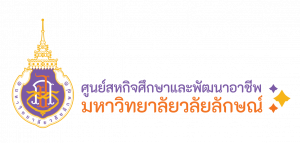Cooperative and Work-Integrated Education : CWIE
1. Definition of CWIE
Cooperative and Work-Integrated Education or CWIE is the curriculum cooperated by higher education institutions and external organizations* to prepare graduates for the world of work completed with the competency to meet the needs of the job market and to develop careers in the present and prepare for future positions.
Cooperative and Work-Integrated Education: CWIE is one of the class management methods that higher education institutions and external organizations co-operate by combining classroom learning with practical career work experience (Work Integrated Learning) to fill students’ competency in knowledge, skills, attitudes, and values. Moreover, provide students’ qualifications consistent with the job market and world of work in reality. CWIE is the word covering Cooperative Education and Work Integrated-Learning in terms of each pattern such as Sandwich Course, Practicum, Post-course Internship, etc.
World Association for Cooperative & Work-Integrated Education: WACE provided many countries to sign in the Global Cooperative and Work-Integrated Education Charter on 5th August 2019. For showing intentions and pushing the higher education institutions around the world to adapt class management into CWIE, it creates competent graduates for the world of work in the modern world and expands to study and work in many countries, and the goal is to provide every student accessing experiential education equally and increasing the chances to exchange CWIE practice in abroad.
2. Guideline and Process of CWIE
Organizing a systematic and standardized CWIE curriculum is the operation based on the platform of Manpower Demand Driven Education Platform for Employability and Career Development through Cooperative and Work-Integrated Education (CWIE): University – Workplace Engagement. There are 5 processes developed under the cooperation of the quad (higher education institution, public or private organization, community, and locality) as follow:
2.1 Information is the process to provide information for creating comprehension between students and higher education institutions and external organizations about ideas, standards, management, and benefits of CWIE. It is anticipated to have co-ideal and expand the result in increasing quantity and standard of creating graduates completed with the competency and met the needs of students and employers.
2.2 Matching is the producing the stage for matching the cooperation between demand and supply through CWIE database of Office of the Permanent Secretary for Higher Education Science Research and Innovation for facilitating the study and searching for each other through electronic systems; for example, course data, number of students, the enterprises, job positions, competencies to be co-produced, allowance or service for students, including to following up on the employment status of the graduates which these are the central database and information used for policy purposes.
_______________________
* External Organizations include the public, industrial, private, civil society, and community entrepreneurs (Cited by Higher Education Act B.E.2562 (2019) in the section of 28 and 35.)
2.3 Co-designing and Implementation or the important key of CWIE are the competencies of students. After matching cooperation, both must codesign curriculums and student results in terms of competency, administrative system, and duties of each section; for example, student preparations before practice, academic supervisor, job supervisor, competency evaluation, allowance, service, safety systems, etc.
2.4 Assessment and development are reviews, student evaluations, including issue management for improving lead to PDCA cycle.
2.5 Outreach Activities is to extend and upgrade CWIE for raising value for students, institutions, and external organizations; for example, career development for the future), International CWIE organizing, encouraging students to be entrepreneurs, enhancing external by doing in-depth researches with the higher education institutions, etc.
3. Curriculum Principles of CWIE (4 Key Characteristics of CWIE)
3.1 University – Workplace Engagement is the cooperation between higher education institutions and external organizations to create competent graduates for the world of work matching job market needs in the present and future.
3.2 Co-design Curriculum is co-design for emphasizing student competencies connected with the world of the job by creating a balance between academics, professions, and life recipes.
3.3 Competency-based Education is learning management to gain competency and to practice solving problems. It has the measurement and competent evaluation systematically.
3.4 Experiential – based Learning must be authentic practice and evaluation, and it must have the process of creating learning in an external organization.
4. CWIE curriculum management type
4.1 ‘Separate’ is to complete learning required theories at higher education institutions; after that, go to practice at the external organizations such as Cooperative Education, etc.
4.2 ‘Sandwich’ is theoretical learning in higher education institutions switched with authentic practices in external organizations entire course such as Sandwich Program, etc.
4.3 ‘Mix’ includes part of theoretical learning in higher education institutions and part of theoretical learning and practice in external organizations. It is a mixture of curriculum management in 5.1 and 5.2 such as learning management based on working in the case of ‘Samui Model’ of Walailak University in Tourism Industry and Hospitality Program, etc.
However, all 3 CWIE managements must be the cooperation of learning management between higher education institutions and external organizations for student development.
